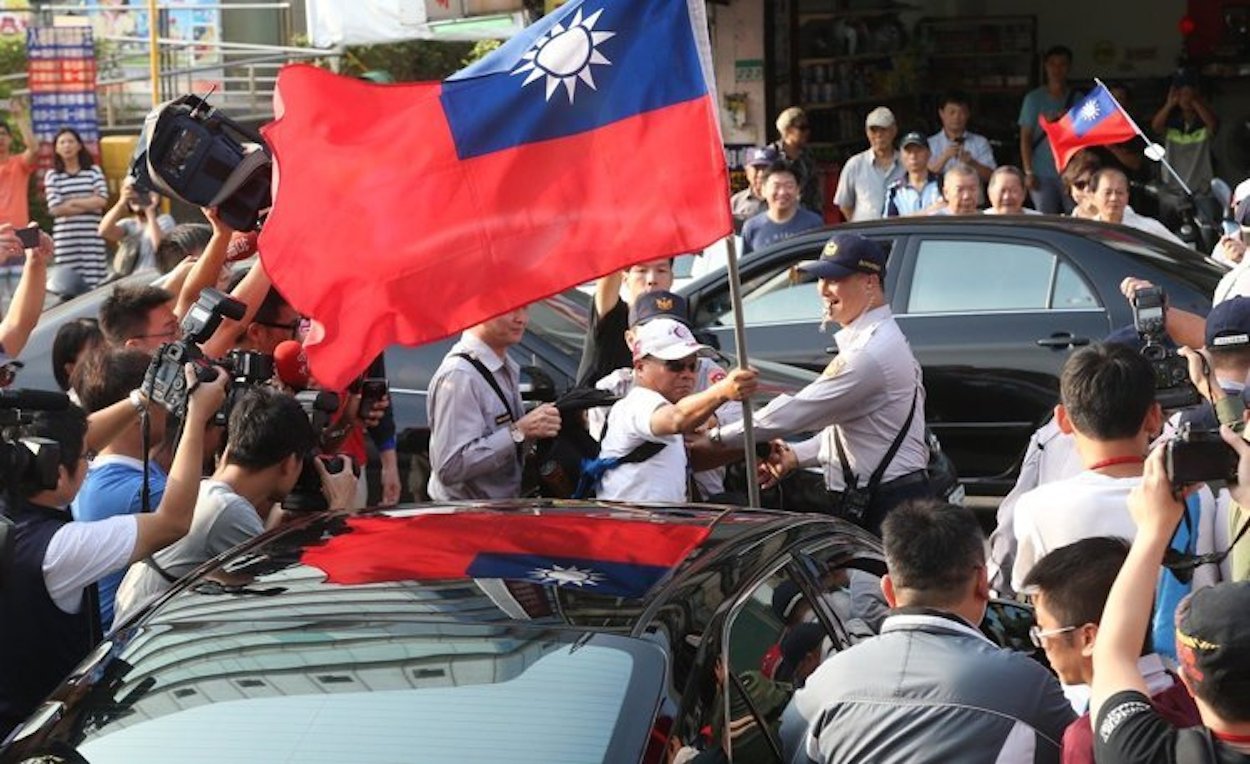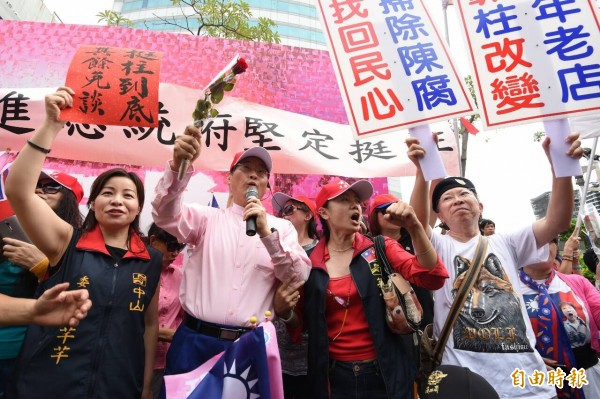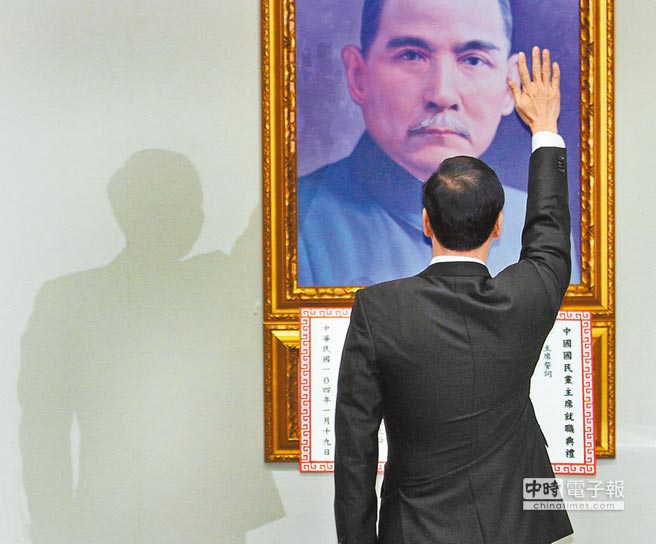by Brian Hioe
語言:
English
Photo Credit: Lin Junliang/UDN
The Shoe On the Other Foot?
THE BIZARRE SPECTACLE of KMT members demonstrating in front of KMT headquarters this past Wednesday prompted some ironic remarks from the Taiwanese activist community on social media. “Damn! The KMT is hardcore!” remarked an individual who had been involved in the recent Ministry of Education occupation on Facebook, observing demonstrators trying to block vehicles of the KMT Central Committee from leaving the building. “Why can’t we do that?” said a Sunflower movement activist in response. Photos from the Apple Daily, who seemed to be first one on the scene, quickly circulated like wildfire through activist networks. Later, we would see Internet memes mocking the event including, quite memorably, a rather witty poem written in classical Chinese posted on PTT.
The demonstration was about current internal machinations within the KMT to replace current presidential candidate Hung Hsiu-Chu with current KMT chairman Eric Chu. This last minute turnabout would contravene the KMT charter, thus requiring amendment of the constitution, and though many have been calling for Hung’s replacement for some time, it is still a last minute upset that a plan to replace Hung would in fact be launched. With such changes, in the future the KMT may be open to lawsuit from Hung, who was generally on the basis of past behavior expected to willfully resist attempts to replace her. The process of replacing Hung could be a messy and protracted one, not to mention a media spectacle like nothing else we have seen in this election cycle yet, unless recent reports that Hung would be willing to peacefully withdraw are true.
 Clashes outside KMT headquarters. Photo credit: Lin Junliang/UDN
Clashes outside KMT headquarters. Photo credit: Lin Junliang/UDN
But as many have pointed out, in strange and ironic fashion the shoe would seem to be on the other foot now. What we saw Wednesday was not activists or members of Taiwanese civil society demonstrating the KMT, but the KMT demonstrating itself. More significantly, where this is revealing of present splits within the KMT, the demonstration would be revealing of, to use J. Michael Cole’s phrasing in his report on the protests, that the “Pan-Blue camp is at war with itself”.
Splits Within Splits in the KMT
ALTHOUGH MUCH has been discussed about the significance of the demonstration outside KMT headquarters, probably what has been less remarked upon is how the demonstration is revealing of somewhat surprising splits within the KMT. When we talk of factional in-fighting within the KMT, we usually speak of Ma Ying-Jeou’s “Mainlander” faction as arrayed against Wang Jinpyng’s “Taiwanese” faction, the latter of which is by degree more “Taiwan-ized” and in some instances can actually have close ties with DPP politicians. The “Mainlander” faction is far closer to KMT orthodoxy and largely controls the current KMT establishment, where the “Taiwanese” faction offers the possibility of reform within the party. But the conflict we saw Wednesday was not between these two factions.
Both Hung and Eric Chu, who would replace her as presidential candidate, are members of Ma’s “Mainlander” faction. Actually, before the improbable ascent of Hung from obscurity to becoming presidential candidate of the KMT, it is true that Wang Jinpyng was, like Chu, maneuvering so that in the absence of any strong presidential candidate the party would come to him and ask him to be the presidential candidate. Wang and Chu both seemed to want to avoid aggravating internal tensions between the “Mainlander” and “Taiwanese” faction which might prove disastrously splitting of the party by projecting an image of not wanting presidential candidacy selfishly, but being willing to take on presidential candidacy for the good of the party.
Maybe it was that both chose to take this step which prevented either of them from actually attaining the position, although we might note that Chu’s position already seemed decidedly stronger than Wang’s at that point in time. Moreover, Wang seems on the brink of reaching the end of his political shelf life because he would likely unable to secure a legislative seat in future election, and, as the longest reigning president of the Legislative Yuan in office since 1999, is already quite old at 74. Chu is, by contrast, a much younger politician at 54. Regardless, it was this strange power vacuum allowed for Hung to take the presidential nomination in the absence of any other candidates.
However, what is interesting to note is that Chu and Hung both belong to Ma Ying-Jeou’s “Mainlander” faction of the KMT. But that Hung’s supporters are coming into conflict with Chu is indicative of less discussed splits within the “Mainlander” faction in and of itself. We would do well to pay close attention to the demographics of demonstrators in support of Hung. Apart from the fact demonstrators were apparently largely elderly—yet another sign of the political obsolescence of the KMT—no less than “White Wolf” Chang An-Lo would come out to support Hung against Chu!
Chang, the infamous gangster who carried out political assassinations for the KMT in the 1980s and turned pro-China politician, has in the year since the Sunflower Movement taken to showing up at demonstrations with his entourage in order to seek media attention. During the Sunflower Movement, he threatened to forcibly evict student occupiers from the Legislative Yuan, and later turned up with an entourage of several hundred gangsters but did not carry out his threat. He would later do much the same with the Ministry of Education occupation in August. However, that Chang was among the demonstrators in support of Hung and against Chu replacing her would seem to indicate something about the extremist composition of Hung’s diehard supporters.
Namely, the split within the “Mainlander” faction of the KMT which has Hung supporters arrayed against Eric Chu and the KMT establishment—the Central Committee of the KMT being on board with the plan to replace Hung with Chu—is a split between ideological doctrinaire “Deep Blues” and less radical elements. In the absence of any ability to appeal to the general Taiwanese public or the notion that she needs do so in order to win the presidential campaign, Hung has instead directed her appeals to the ideologically fanatical “Deep Blues” of the KMT who seem much more responsive.
While for the Taiwanese public at large, Hung’s appeals only serve to point to her inability to capture the support of the public at large in order to win the presidential election, within the “Deep Blue” echo chamber, it may actually be that Hung appears as a godsend! After the past year of blows against the KMT, whether through the eruption of the Sunflower Movement or Ministry of Education occupation, or through the defeat of nine-in-one elections, finally a messianic figure of ideological purity has arrived to save the party! Because in order to recapture the glory days of the KMT, the party needs only to go back to the fundaments of Sun Yat-Sen’s Three Principles of the People!
This is, of course, further illustrative of the fundamental disconnect between “Deep Blues” and Taiwanese society at large. But it may be only in light of that the “Deep Blue” ideology is actually quasi-mystical in nature regarding Sun Yat-Sen’s Three Principles of the People understood as a transcendent ideal for politico-moral social order that we can then understand why Hung at a certain stage of her campaign began writing Facebook posts that tend towards gnomic mysticism, referencing everything from Buddhism to fanciful, moral fables.
 “White Wolf” Chang An-Lo at the demonstration outside KMT headquarters. Photo credit: Jian Rongfeng/Liberty Times
“White Wolf” Chang An-Lo at the demonstration outside KMT headquarters. Photo credit: Jian Rongfeng/Liberty Times
And if now we see splits even within the “Mainlander” faction between “Deep Blues” and less radical forces, it would seem that with Hung’s rise, there was the real danger of “Deep Blue” fanatics coming to call the shots within the KMT. In this light, we can maybe understand the conflict of Hung versus the KMT establishment as, again, illustrative of a factional conflict within the “Mainlander” faction of the KMT, but also not purely a struggle about upcoming elections. It may be that with the KMT in crisis, what we are seeing is a struggle between extremists threatening to take control of the party and the establishment hanging on for dear life.
Because now not only would Wang Jinpyng’s “Taiwanese” faction be a threat to the “Mainlander” KMT establishment in possibly pushing for party reforms aimed at “Taiwan-izing” the party. Now there are radical voices within the “Mainlander” faction itself who claim against the apparent need of the KMT to reform or “Taiwan-ize” in some way to win over a public increasingly disillusioned with its disconnect from its pro-China political stances and disconnect from Taiwan, that what the KMT needs instead is to revive the traditional values of the party. This would, of course, mean the death of the party.
A Struggle for the Survival of the KMT?
NEVERTHELESS WHAT has gone unremarked on is the question of why exactly Chu would, after all this time, seek to enter the race. If Chu and Wang were both hoping that the party would come begging to them to take candidacy, another consideration as to why they would be reluctant to enter the race was because of the slim odds of victory. To date, it still would be an uphill struggle for Chu to win the race; Tsai’s ratings being what they are, and polls showing a low likelihood for Chu to win. And the struggle to oust Hung may just worsen the KMT’s standing in elections further given that the struggle will be highly public in nature and a mass spectacle like no other.
We might ask: Is it that Chu is falling on the sword for the sake of the party? Though Chu has claimed it would be an act of self-sacrifice to take up the position of presidential candidacy throughout and this has largely been dismissed, what if there is in fact some truth to this. Because if the “Mainlander” KMT establishment is now fighting off extremists such as Hung’s supporters, this may be a struggle for the survival of the KMT which takes the form of a struggle for the so-called “soul” of the party—that is, this is a struggle between two very different visions for the party between the extremists who have put themselves behind Hung and less radical members of the establishment who are now lining behind Chu.
 Eric Chu being sworn in as party chairman of the KMT. Photo credit: Zhao Shuangjie/China Times
Eric Chu being sworn in as party chairman of the KMT. Photo credit: Zhao Shuangjie/China Times
To pose a provocative scenario, perhaps it is that Chu’s entering the race is not solely for the reason of that he would be a better presidential candidate for the KMT. Even if Chu stands no chance of winning elections, ousting Hung may at least rescue the KMT from having the extremists coming to call the shots if this leads to the isolation of Hung and her radical supporters from the KMT at large.
It may be questioned as to whether Chu is so self-sacrificing as a politician, hence why this is a hypothetical scenario posed as an exercise in speculation. Even if he stands no real chance of winning the presidency, Chu may still deem running at this point to the most politically expedient move in that it will serve to raise his overall profile as a politician. Yet we should keep in mind that the conflict between Hung and Chu is very likely reflective of internal factional conflict within the KMT in its current moment of crisis as it seeks to prevent itself from being swept away. The attempt at replacing Hung with Chu may be a product of internal factions within the KMT fighting for dominance as much as it is because of the approach of elections. And reflective of the moment of crisis the KMT is in, this factional conflict is not between traditional party divisions of the more revisionist “Taiwanese” faction and the “Mainlander” establishment, but a fracture within the “Mainlander” establishment itself.
But we will know more in the coming weeks until 2016 elections. Because if what we are seeing now is a internal struggle for the survival of the KMT, perhaps what we are actually watching is its slow, protracted motions in the act of dying.




